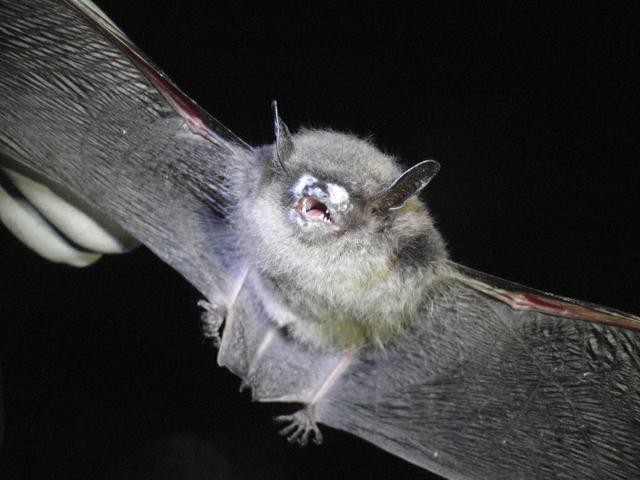In a mere two years, the bat population in a Haywood County mine has dropped from 4,000 to 250, North Carolina Wildlife Resources Commission biologists report. White nose syndrome appears to be the culprit. The deadly disease has spread to 20 states. Last year, infected bats were discovered in the Great Smoky Mountains Park, and this year, in late May, the spread of the disease reached even further: Bats in a mine in northern Illinois, just 100 miles from the Wisconsin border, were diagnosed with white nose syndrome.
Of the 17 species of bats found in North Carolina, four appear to be afflicted with the syndrome.
Why worry about bats? It’s bad news for healthy ecosystems. For starters, farmers could feel the impact of the deadly fungus, because bats can eat their body weight in insects each night, says Resources Commission biologist Gabrielle Graeter. More exactly, bats feed on agricultural pests that destroy crops.
Without bats, North American agricultural losses could total almost $4 billion per year, estimated Justin Boyles, Southern Illinois University researcher and author of “Economic Importance of Bats in the 'Billions a Year' Range.”
Graeter puts it this way: With the number of bats in WNC decreasing, farmers may have to use more pesticides (which, in turn, could be a factor in the decline in bee populations). Bats also eat mosquitoes, which can infect their human victims with La Crosse encephalitis.
Unfortunately, the syndrome’s an alarmingly swift killer. Some infected areas have seen 95 percent mortality rates, according to the NCWRC and the U.S. Fish and Wildlife Services. Infected bats are most commonly seen in winter during hibernation, Graeter explains. Cool cave temperatures encourage the growth of the fungus. “Some of the things that are seen when [the bats have] white nose is that they wake up more often, presumably because it’s irritating their skin,” she says. With the bats shutting down their bodies — and most importantly, their immune systems — white nose can easily creep in. The infected bats will also sleep near cave entrances, exposing the weakened creatures to WNC winter weather. And bats with the syndrome are usually emaciated, their hibernation cycles interrupted as they’re forced to try feeding in winter, when there are few insects.
The bat population in a McDowell County cave dropped from around 300 to just a few remaining survivors since the syndrome was first discovered in the region.
The disease has been found in bats in Rutherford County, too.
So far, two bats have been found in Buncombe County. The first was found in 2011, and this year, a dead bat was found on a resident’s porch. Sent to Raleigh for analysis, it was confirmed to have white nose syndrome.
Despite the disease’s name, it isn’t always easy to spot, Graeter notes. The fungus grows underneath the bat’s skin, so sometimes the only way to confirm the fungus is to use a microscope.
Biologists hope to slow the spread of the disease. “The No. 1 thing we’re asking people right now is to try and avoid going caving,” says Graeter. She notes that although the fungus typically spreads from bat to bat, humans can unknowingly transfer it when exploring caves. Those who do go caving are asked to follow decontamination protocol. The resource website whitenosesyndrome.org lists soaking items in water above 122 degrees for 20 minutes, or in bleach for 10 minutes as ways to properly decontaminate hiking gear and clothing.
There are also efforts underway to track the infection rate and the spread of the disease. Gary Peeples, public affairs officer for the Asheville branch of the FWS, says that specialists gather suspected bats by monitoring areas known to carry the fungus. If a team finds a dead bat in a suspected area, the bat gets sent to various labs that test for WNS. “By going out and checking the same network of caves, we can get an idea of how far it’s spreading,” says Peeples. “By counting the bats, [we] can get an idea of how it’s impacting the bat community.”
The FWS and the nonprofit Southeastern Bat Diversity Network have also been working with the bat community. People are encouraged to report any suspicious bat behavior, says Graeter. “It’s really helpful for people to keep an eye out for irregular activity.”
By simply paying attention to bat behavior, the public can help stop the spread of the deadly white nose syndrome. With the community and organizations like the FWS working together, offering hope to the future of bats in WNC.
For more information on white nose syndrome and a complete list of decontamination protocols, visit whitenosesyndrome.org, the U.S. Geological Survey resource website at http://avl.mx/uw or the Southeastern Bat Diversity Network at sbdn.org.
— Brandy Carl is an Xpress news intern and a senior at Western Carolina University. She can be reached at brandy@mountainx.com or 251-1333, ext. 128.



Before you comment
The comments section is here to provide a platform for civil dialogue on the issues we face together as a local community. Xpress is committed to offering this platform for all voices, but when the tone of the discussion gets nasty or strays off topic, we believe many people choose not to participate. Xpress editors are determined to moderate comments to ensure a constructive interchange is maintained. All comments judged not to be in keeping with the spirit of civil discourse will be removed and repeat violators will be banned. See here for our terms of service. Thank you for being part of this effort to promote respectful discussion.